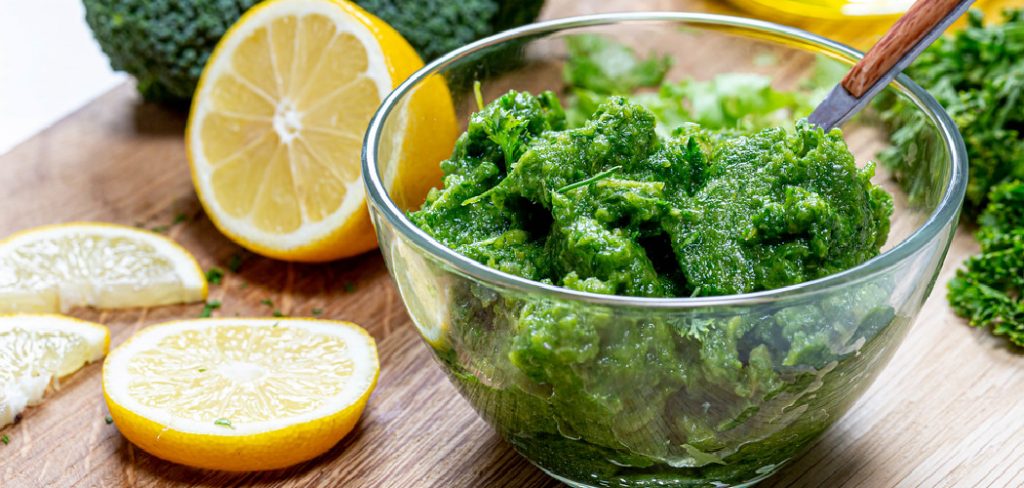If you have ever made pesto at home, you’ve come across the problem of bitterness. It’s not pleasant, and it can ruin an otherwise delicious dish. But never fear! A few simple tips and tricks can help you avoid bitter pesto. Read on to find out how to fix bitter pesto every time.

Summary: This blog post will provide you with a step-by-step guide on how to fix bitter pesto. We’ll discuss how to identify the source of the bitterness, adjust ingredients and season with salt and pepper.
We’ll also explain how to add acid, sweetness, olive oil and remove the bitterness before seasoning to taste. Finally, we’ll give you tips on how to serve and enjoy your delicious pesto dish. After reading this article, you’ll be able to create a perfect batch of pesto every time.
What Is Bitter Pesto?
When chlorogenic acid is present in high levels, it can cause pesto to become bitter. This compound is responsible for the peppery, herbaceous flavor of the herb, as well as its bitter taste. When too much of it is present in pesto, the dish can become unpalatably bitter.
The chlorogenic acid levels in your pesto might be too high for a few reasons. If you’re using very mature basil leaves, they will likely contain more of the compound than younger leaves. Additionally, if you use the herb’s stems in your pesto (something that is often done to avoid wasting any part of the plant), they will also contribute to the bitterness.
Why It’s Important to Fix Bitter Pesto?
If your pesto tastes bitter, it’s probably because the herbs and spices in it are not balanced correctly. You can fix this by adding more of the other ingredients until the bitterness goes away. Another reason for bitterness is using too much olive oil. If you think this is the problem, try using less olive oil next time.
When making pesto, it’s important to use a good quality olive oil, but be careful not to add too much. The final flavor of your pesto should be bright and fragrant, with a slight bitterness from the herbs. However, if it tastes overwhelmingly bitter, that’s a sign that something has gone wrong. If you’re using a food processor to make your pesto, it’s important not to over-process the ingredients. You want the final product to be a thick paste, not a smooth liquid.

A Step by Step Guide on How to Fix Bitter Pesto
Step 1: Identify the Cause of Bitterness
Determine the source of bitterness in your pesto. Common culprits include over-toasting pine nuts, using too much garlic, or incorporating older, more mature basil leaves. Understanding the cause of the bitterness will help you decide on the best course of action for fixing the issue.
Step 2: Gather Additional Ingredients
To counteract the bitterness in your pesto, you may need to add more of the original ingredients or introduce new ones. Have the following items on hand:
- Fresh basil leaves
- Pine nuts or alternative nuts (e.g., almonds, walnuts)
- Extra virgin olive oil
- Grated Parmesan or Pecorino Romano cheese
- Garlic cloves
- Lemon juice
- Salt
- Honey or sugar (optional)
Step 3: Add More Basil
If the bitterness stems from using older basil leaves, try incorporating more fresh, young basil leaves into the mix. Younger leaves tend to be sweeter and milder in flavor. Add a small amount at a time and taste the pesto as you go, making adjustments as necessary.
Step 4: Adjust the Nut Ratio
Over-toasted pine nuts can contribute to bitterness. If you suspect this is the issue, consider adding untoasted pine nuts or replacing them with a milder alternative, such as almonds or walnuts. Add a small amount at a time, tasting and adjusting as needed.
Step 5: Reduce Garlic Intensity
If too much garlic is causing the bitterness, there are a few ways to mitigate the issue:
- Remove some of the garlic from the pesto.
- Blanch the garlic cloves in boiling water for 30 seconds to a minute before incorporating them. This can help reduce their pungency.
- Roast the garlic cloves before adding them to the pesto. Roasting garlic mellows its flavor and adds a subtle sweetness.
Step 6: Balance with Cheese
Adding more grated Parmesan or Pecorino Romano cheese to your pesto can help balance the bitter taste. The cheese’s saltiness and creaminess can counteract the bitterness and provide a more rounded flavor. Add cheese in small increments, tasting and adjusting as necessary.
Step 7: Introduce Lemon Juice
Lemon juice can help neutralize bitter flavors in pesto by adding acidity and brightness. Start by adding a small amount of freshly squeezed lemon juice and tasting the pesto. Continue to add more lemon juice in small increments until the bitterness is reduced to your liking.
Step 8: Season with Salt
Sometimes, simply adding a bit of salt can counteract the bitterness in your pesto. Salt helps enhance other flavors, making the bitterness less prominent. Be cautious when adding salt, as too much can make the pesto overly salty. Add a small pinch at a time, tasting and adjusting as needed.
Step 9: Sweeten with Honey or Sugar (Optional)
If the bitterness in your pesto is particularly stubborn, you can try adding a small amount of honey or sugar to help balance the flavors. Be cautious when using this method, as too much sweetness can alter the pesto’s taste significantly. Add a small amount at a time, tasting and adjusting as necessary.
Step 10: Adjust Olive Oil Content
In some cases, adding more extra virgin olive oil can help mellow the bitter taste of pesto. The oil’s richness can round out the flavors and improve the overall mouthfeel. Drizzle in additional olive oil slowly, tasting and adjusting as needed.
Step 11: Taste and Adjust
As you add ingredients to counteract the bitterness in your pesto, be sure to taste the sauce frequently. This will help you monitor the changes in flavor and ensure that you don’t over-correct the issue. It’s essential to make adjustments in small increments to avoid introducing new problems or masking the intended flavors of the pesto.
Step 12: Blend the Pesto
After making adjustments to the ingredients, blend the pesto once more to ensure that all the components are well-incorporated and evenly distributed. Use a food processor or blender to achieve a smooth, homogenous texture.
Step 13: Let the Pesto Rest
Allow the adjusted pesto to rest for at least 30 minutes before serving. This resting period will enable the flavors to meld and develop, leading to a more balanced and harmonious taste.
Step 14: Serve and Enjoy
Once the bitterness has been addressed and the pesto has rested, it’s time to enjoy your creation. Serve the pesto with pasta, as a spread on sandwiches, or as a dip for vegetables and crackers. Remember to store any leftover pesto in an airtight container in the refrigerator for up to a week.
Step 15: Learn from Experience
Take note of the adjustments you made to your pesto recipe to address the bitterness. This will help you avoid similar issues in the future and ensure consistently delicious results. Consider the quality and freshness of your ingredients, as well as the proportions used in the recipe.
Step 16: Experiment with Variations
Don’t be afraid to experiment with different ingredients and ratios to create your ideal pesto. You may find that using a particular type of nut, cheese, or herb yields a more pleasing and well-balanced flavor profile. Exploring various combinations and techniques can help you refine your pesto-making skills and discover new flavor possibilities.
Step 17: Share Your Success
Once you’ve mastered the art of fixing bitter pesto, share your success with friends and family. A well-crafted, delicious pesto is a versatile and crowd-pleasing dish that can elevate any meal. By sharing your knowledge and expertise, you can help others improve their culinary skills and enjoy the satisfying experience of creating a perfectly balanced pesto.
By following these steps and making adjustments as needed, you can successfully fix bitter pesto and create a flavorful, well-balanced sauce that complements a wide variety of dishes. By learning from your experiences and experimenting with different ingredients and techniques, you can continue to refine your pesto-making skills and consistently produce delicious, satisfying results.
Can I Add Water to Pesto?
One possible solution to fixing a too-bitter pesto is to add water. This will dilute the flavor somewhat but can help make the sauce more palatable. Another option is to add some grated Parmesan cheese, tempering the flavor. If you have any other herbs on your hands, such as basil or mint, you can also add a bit of those to help balance out the flavors. Finally, if all else fails, you can make a new batch of pesto without adding as much of the bitter ingredients.

While it may not be ideal, sometimes the best solution is to start over. With a few adjustments, you can hopefully make a pesto that is edible and delicious. Keep reading for more information about how to fix bitter pesto.
How Long Does Pesto Keep in The Refrigerator?
The shelf life of pesto depends on how it was made. Homemade pesto will typically last around 3-5 days in the fridge, while store-bought pesto can last two weeks.
When Making Pesto Can You Use the Stems?
Yes, you can use the stems when making pesto. Just be sure to remove any woody stems before blending. The leaves will give the pesto plenty of flavor, so there’s no need to worry about using the stems.
Why Does My Pesto Taste Like Grass?
There are a few reasons why your pesto might taste like grass. One possibility is that you didn’t use enough salt. Another possibility is that you didn’t use enough olive oil. Finally, it’s also possible that you used too much parsley. If your pesto tastes like grass, try using less of the herbs that you don’t like the taste of. You can also add more olive oil or salt to help balance out the flavors.
What to Add if Pesto Is Bitter?
If your pesto is too bitter, you can add a few things to help offset the bitterness. First, try adding a bit of sweetness, such as honey or sugar. You can also add acidities, such as lemon juice or vinegar. Finally, try adding more salt. These additions will help balance the flavors and make your pesto more palatable. Finally, if all else fails, you can try diluting the pesto with some additional olive oil or water.
Why Is Your Pesto Bitter?
If your pesto is bitter, it may be because you used too much of the herb. When making pesto, always start with a small amount of herb and add more as needed. You can also adjust the salt or lemon juice to taste. If your pesto is still bitter after adjusting these ingredients, try using a different type of cheese. A milder cheese will help to balance out the bitterness.
How Do You Make Pesto Sauce Less Salty?
If your pesto sauce is too salty, you can do a few things to fix it. First, try adding more of the ingredients that make up the sauce, like olive oil, cheese, or nuts. If that doesn’t work, you can also dilute the sauce with a bit of water or stock. Finally, if all else fails, you can always add a pinch of salt to the sauce until it reaches the desired level of saltiness.
Frequently Asked Questions
Why Did My Pesto Come Out Bitter?
There are a few potential reasons why your pesto may have come out bitter. The most common reason is that you might not have mixed the ingredients properly. Make sure to stir everything together well before adding it to the food processor or blender.
Another possible culprit could be too much salt, which can inhibit flavor and create bitterness. Finally, acidic foods (e.g., tomatoes) can also cause bitterness in pesto recipes because they add moisture content that competes with other flavors for space on your taste buds.
Do You Make Basil Less Bitter?
Yes, you can make basil less bitter by steaming or boiling it instead of frying it. Steaming or boiling will reduce the amount of oil that is used and result in a tastier Basil experience!
What if I Put Too Much Garlic in My Pesto?
If you put too much garlic in your pesto, it can cause it to turn darker in color, have a garlic flavor, and become difficult to consistency. To fix this, simply add more of the pesto ingredients- olive oil, pine nuts, and Parmesan cheese- until the desired consistency is reached.
Should I Blanch Basil Before Making Pesto?
Basil is a great herb for pesto, but many people believe that it’s best to blanch it first. Blanching basil removes the bitterness and helps to preserve the flavor. To blanche your basil, place it in boiling water for 3-5 minutes or until its leaves are slightly soft.
Does Lemon Keep Pesto Green?
Yes, Lemon can keep pesto green. Pesto is a popular Italian sauce that typically consists of basil, garlic, olive oil, and salt. When making the sauce, lemon juice helps to preserve the color and flavor of the ingredients while preventing them from going brown.
Conclusion
So, how to fix bitter pesto? Add more salt. The next time you make pesto, add an extra pinch of salt and see if that doesn’t help balance out the flavors. You may also need to adjust the other ingredients in your recipe until you find the perfect balance for your palate. With a bit of experimentation, you should be able to make delicious pesto every time. Have you ever made pesto that was too bitter? How did you fix it?
You Can Check It Out To Fix Undercooked Potatoes
